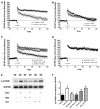Environmental enrichment improves learning and memory and long-term potentiation in young adult rats through a mechanism requiring mGluR5 signaling and sustained activation of p70s6k
- PMID: 26341144
- PMCID: PMC4938427
- DOI: 10.1016/j.nlm.2015.08.006
Environmental enrichment improves learning and memory and long-term potentiation in young adult rats through a mechanism requiring mGluR5 signaling and sustained activation of p70s6k
Abstract
Previous studies from our lab have demonstrated that mild cognitive impairments identified early in life are predictive of cognitive deficits that develop with age, suggesting that enhancements in cognition at an early age can provide a buffer against age-related cognitive decline. Environmental enrichment has been shown to improve learning and memory in the rodent, but the impact of enrichment on synaptic plasticity and the molecular mechanisms behind enrichment are not completely understood. To address these unresolved issues, we have housed 2-month old rats in environmentally enriched (EE), socially enriched (SE), or standard housing (SC) and conducted tests of learning and memory formation at various time intervals. Here we demonstrate that animals that have been exposed to one month of social or environmental enrichment demonstrate enhanced learning and memory relative to standard housed controls. However, we have found that after 4months EE animals perform better than both SE and SC groups and demonstrate an enhanced hippocampal LTP. Our results demonstrate that this LTP is dependent on mGluR5 signaling, activation of ERK and mTOR signaling cascades, and sustained phosphorylation of p70s6 kinase, thus providing a potential target mechanism for future studies of cognitive enhancement in the rodent.
Keywords: Environmental enrichment; Metabotropic glutamate receptor; Morris water maze; Object recognition; Young rats; p70s6 kinase.
Copyright © 2015 Elsevier Inc. All rights reserved.
Figures






References
-
- Bashir ZI, Bortolotto ZA, Davies CH, Berretta N, Irving AJ, Seal AJ, … Collingridge GL. Induction of LTP in the hippocampus needs synaptic activation of glutamate metabotropic receptors. Nature. 1993;363(6427):347–350. - PubMed
-
- Bekinschtein P, Katche C, Slipczuk LN, Igaz LM, Cammarota M, Izquierdo I, Medina JH. MTOR signaling in the hippocampus is necessary for memory formation. Neurobiology of Learning and Memory. 2007;87(2):303–307. - PubMed
-
- Bortolotto ZA, Bashir ZI, Davies CH, Collingridge GL. A molecular switch activated by metabotropic glutamate receptors regulates induction of long term potentiation. Nature. 1994;368(6473):740–743. - PubMed
-
- Bortolotto ZA, Collett VJ, Conquet F, Jia Z, van der Putten H, Collingridge GL. The regulation of hippocampal LTP by the molecular switch, a form of metaplasticity, requires mGlu5 receptors. Neuropharmacology. 2005;49(1):13–25. - PubMed
Publication types
MeSH terms
Substances
Grants and funding
LinkOut - more resources
Full Text Sources
Other Literature Sources
Medical
Miscellaneous

